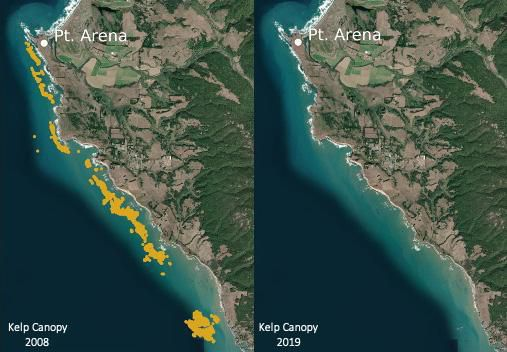Researchers say they’re not sure these iconic coastal ecosystems will be able to make a comeback anytime soon.

Satellite images comparing bull kelp canopy cover (gold shading) 2008 and 2019 off the coast of Mendocino and Sonoma Counties in Northern California.
The coastal waters of Northern California are changing. A decade ago, hundreds of miles of the rugged seaside were flanked by thick, swaying underwater forests of amber-green bull kelp that were home to fish, abalone and a host of other species. Now, those forests have been nearly wiped out by a series of environmental events that have been falling like ill-fated dominos since 2013.

A healthy patch of bull kelp forest photographed at Pescadero Point
A new study using satellite imagery and underwater surveys is the latest to confirm that these majestic marine ecosystems have all but disappeared, reports Tara Duggan for the San Francisco Chronicle. Satellite images dating back to 1985 show that bull kelp forests off Sonoma and Mendocino counties have declined by a devastating 95 percent since 2013, and, according to the Chronicle, researchers are concerned the kelp may not be able to bounce back anytime soon.
The results, reported last week in the journal Communications Biology, are the first to use satellite images to quantify the ecological losses that have racked up over the last eight years, the Associated Press reports. Across the more than 200 miles of coast encompassed by the study, kelp forests have been almost completely replaced by barren stretches of sea floor covered in spiky purple sea urchins.
Purple sea urchins are marine grazers that love to munch on kelp, and in 2013 one of their biggest predators, the sunflower sea star, abruptly started wasting away due to a still-mysterious disease that has ravaged the many-armed invertebrates from Mexico to Alaska.

Many of Northern California’s kelp forests have been replaced by so-called urchin barrens made up of purple sea urchins like these.
As the unchecked purple urchin populations began exploding in number, bull kelp got hit with successive marine heatwaves that made life even harder for the cold water-loving kelp from 2014 to 2016. While these ocean conditions can’t be wholly attributed to climate change, such marine heatwaves are predicted to become more common under climate change.
“There were a lot of disruptions at one time that led to this collapse, and the system now persists in this altered state,” Meredith McPherson, an ocean scientist at the University of California, Santa Cruz and the paper’s first author, in a statement. “It’s a naturally dynamic system that has been really resilient to extreme events in the past, but the die-off of sunflower stars caused the resilience of the ecosystem to plummet. As a result, the kelp forests were not able to withstand the effects of the marine heatwave and El Niño event combined with an insurgence of sea urchins.”
https://www.smithsonianmag.com/smart-news/satellite-imagery-shows-northern-california-kelp-forests-have-collapsed-180977214/